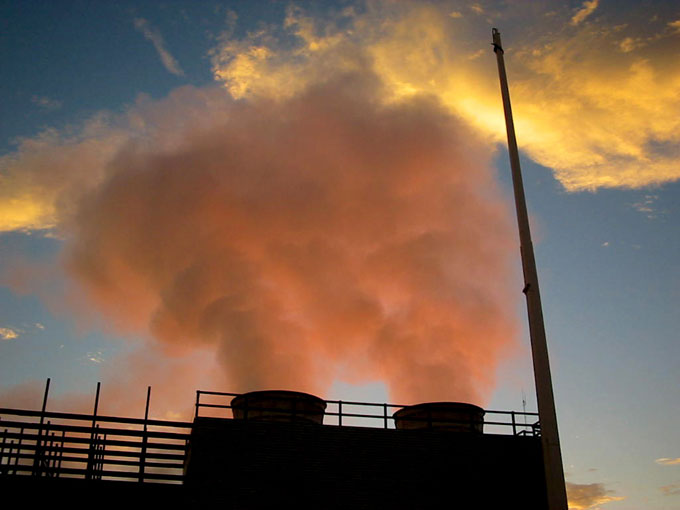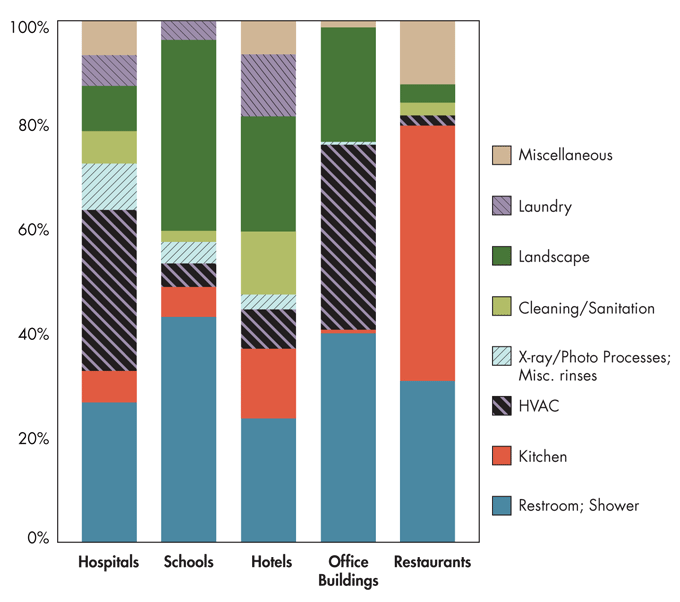Because of the sheer magnitude of water used to operate a cooling tower, implementing a successful water management program and automatic controls can have a much greater overall impact on your building’s water efficiency than retrofitting indoor plumbing fixtures. Depending on your local water rates, it can also bring your project significant cost savings.
Two very different credit options
This credit has two sides, with two separate points available. WEc4.1: Chemical Management addresses chemical management for cooling towers and is highly achievable for any project that has a cooling tower.
WEc4.2: Non-Potable Water Sources involves using non-potable water in your cooling tower—this option is rarely attempted due to the challenges associated with retrofitting an existing cooling tower to use non-potable water sources.
Cooling towers chill buildings by evaporating water. A 100-ton chiller evaporates about three gallons of water per minute (11 lpm), with additional water loss from drift and blowdown. In a typical office building, HVAC equipment accounts for about a third of total water use.
WEc4.1: Chemical Management
Implementing a professional water management program effectively manages the chemicals used to treat the cooling tower makeup water and controls outbreaks of harmful biological organisms, such as Legionella pneumophila, the bacterium that causes Legionnaires’ disease.
This option does not require that your water management plan meet any specific environmental standards or thresholds—only that you have a detailed plan that is written specifically to optimize water management in your cooling tower.
Costs associated with WEc4.1 are minimal, especially if automatic bleed-off controls are already installed on your cooling tower. Work with your management contractor to successfully integrate the LEED requirements into contract language and ongoing operational procedures.
Follow these two requirements for WEc4.1:
- In cooperation with your cooling tower management contractor, implement a water management plan that clearly defines processes and procedures for chemical management, bleed-off, biological control, and staff training. Your existing contract may meet the LEED requirements with little or no modification, but make sure that it thoroughly addresses each of the requirements. If the contract only provides partial information, it may be necessary for you to develop a separate document.
- Install and maintain a conductivity meter and controls that automatically adjust the bleed-off rates and minimize the buildup of dissolved solids as the water evaporates.
WEc4.2: Non-Potable Water Sources
WEc4.2 addresses the use of non-potable water in your cooling tower. Non-potable water can be used as cooling tower makeup water if it is treated to eliminate the introduction of biological contaminants. Available sources of non-potable water range from HVAC condensate to collected stormwater to desalinated ocean water. Naturally occurring surface and groundwater do not qualify as appropriate non-potable sources for the purposes of this credit.
Costs associated with WEc4.2 will probably be substantial if you’re not already using non-potable water in your cooling tower. Retrofitting a cooling tower to use non-potable water can be very difficult and costly, due in part to the amount of water treatment needed and also to the sheer amount of reclaimed or captured non-potable water required to effectively operate a cooling tower.
Depending on building type, HVAC can represent a huge portion of overall use.
Consider these questions when approaching this credit
- Does your building have a cooling tower? Sometimes project teams mistakenly believe that if they don’t have a cooling tower, they can qualify because they’re avoiding the environmental impacts of having one. You must have a cooling tower to qualify for this credit.
- What sort of controllability and automation currently exist?
- Can the cooling tower be retrofitted to use non-potable water?
- Are rebates available through your water utility for cooling tower improvements or retrofits?
- What is your current contractor arrangement for cooling tower management? Will the existing contract need to be amended to meet the LEED criteria for the water management plan?
- To what extent does onsite staff perform cooling tower management duties? What training do they receive?

